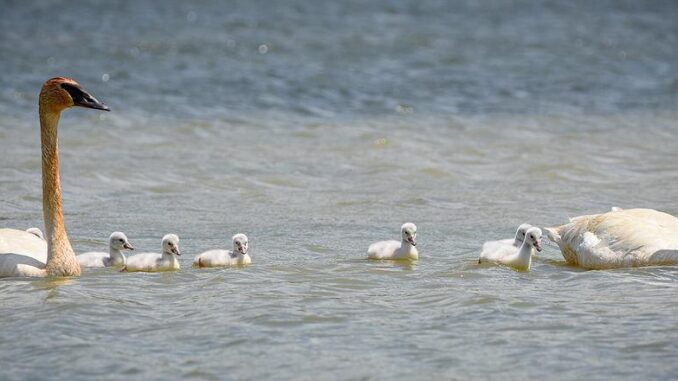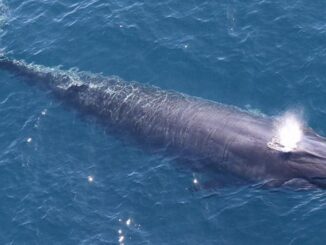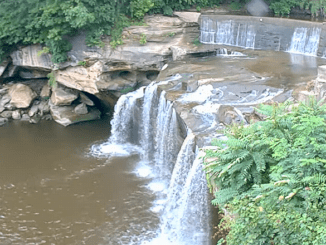
COLUMBUS, Ohio, April 25, 2024 (ENS) – Ohio is celebrating the recovery of the state’s trumpeter swans as a conservation success story. The Ohio Wildlife Council, an eight-member, bipartisan group of citizens, has voted to remove the trumpeter swan from the state’s threatened species list. The delisting crowns a 28-year effort by the Ohio Department of Natural Resources Division of Wildlife to restore a population of trumpeter swans in Ohio.
The Ohio Wildlife Council is appointed by Governor Mike DeWine to advise and assist the Division of Wildlife and to report their findings to the governor. The council reviews and votes on all Division of Wildlife proposed rules and regulations.
Ohio’s trumpeter swan population today numbers nearly 900, with swans nesting in 26 of Ohio’s 88 counties.
“Ohio’s professional wildlife biologists dedicated themselves to growing the trumpeter swan population over nearly three decades, and their perseverance has paid off,” Governor DeWine said.
“In addition to monitoring the growth of the trumpeter swan population, a great deal of work also went into creating and restoring wetland habitat needed for generations of trumpeters to nest and thrive,” the governor said.
The trumpeter swan, Cygnus buccinator, is the heaviest living bird native to North America, and also the largest species of waterfowl still existing on the continent, with a wingspan of up to 10 feet, 2 inches (304.8 cm). The adult trumpeter swan’s plumage is entirely white.
Some populations of trumpeter swans are migratory, although many of Ohio’s trumpeter swans are year-round residents.
They breed in large shallow ponds, undisturbed lakes, pristine wetlands, wide slow rivers, and marshes in northwestern and central North America, with the largest numbers of breeding pairs found in Alaska.
Trumpeter swans were extirpated from Ohio as early as the 1700s. Populations of this largest swan species experienced severe declines throughout North America in the 1700s and 1800s because of unregulated harvest and wetland habitat loss.
By 1933, fewer than 70 wild trumpeters were known to exist, and extinction seemed imminent, until aerial surveys discovered a Pacific population of several thousand trumpeters around Alaska’s Copper River.

Careful reintroductions by wildlife agencies and the Trumpeter Swan Society gradually restored the North American wild population to over 46,000 birds by 2010.
Ohio’s 2010 Swan Management Plan established a goal for delisting trumpeter swans when the population reached 40 or more breeding pairs for three consecutive years. Biologists confirmed more than 40 breeding pairs for the first time in 2015 and every year since. Ohio hosted 152 breeding pairs in 2023.
Another prerequisite for delisting was for trumpeter swans to breed in at least 15 counties. The latest survey documented trumpeters breeding in 26 counties. By both metrics, trumpeter swan populations have surpassed the Division of Wildlife’s management goals for the species.
Following aquatic habitat improvements and successful reintroductions in other Midwest states, the Division of Wildlife began a trumpeter swan reintroduction program in 1996 by collecting swan eggs from an established population at the Minto Flats State Game Refuge in central Alaska.
The eggs were placed in incubators and flown to Ohio, where the Cleveland Metroparks Zoo and The Wilds of the Columbus Zoo partnered to help care for the eggs, raise the young trumpeters, and release them in appropriate habitats.
Wetland complexes on state wildlife areas such as Funk Bottoms, Killdeer Plains, Magee Marsh, and Mosquito Creek provided the critical habitat Ohio’s trumpeters needed. Today, programs such as H2Ohio are restoring more wetlands on public and private lands with benefits of improved water quality for all Ohioans and enhanced wildlife habitats.
Trumpeter swans were listed as an endangered species upon release and populations have been on the rise ever since, leading to a positive downgrade to threatened status in 2012.
“Trumpeter swans represent a great comeback story for Ohio. This is just one of many examples of the conservation work ODNR has been doing for the last 75 years,” Mary Mertz, director of the Department of Natural Resources, said. “Through the hard work and dedication of our staff and conservation partners we can once again see trumpeter swans fly through Ohio’s skies.”
Trumpeters will continue to receive protection in the state under federal and state wildlife laws. The Division of Wildlife’s monitoring and management efforts to increase trumpeter swan populations and their habitat are ongoing.
Featured image: Trumpeter swans mate for life. Originally pure white, these adult swans have necks colored red by the water they dip in to feed. Sandy Ridge Reservation, Lorain County, Ohio. May 25, 2019 (Photo by Jen Goellnitz)
© 2024, Environment News Service. All rights reserved. Content may be quoted only with proper attribution and a direct link to the original article. Full reproduction is prohibited.



